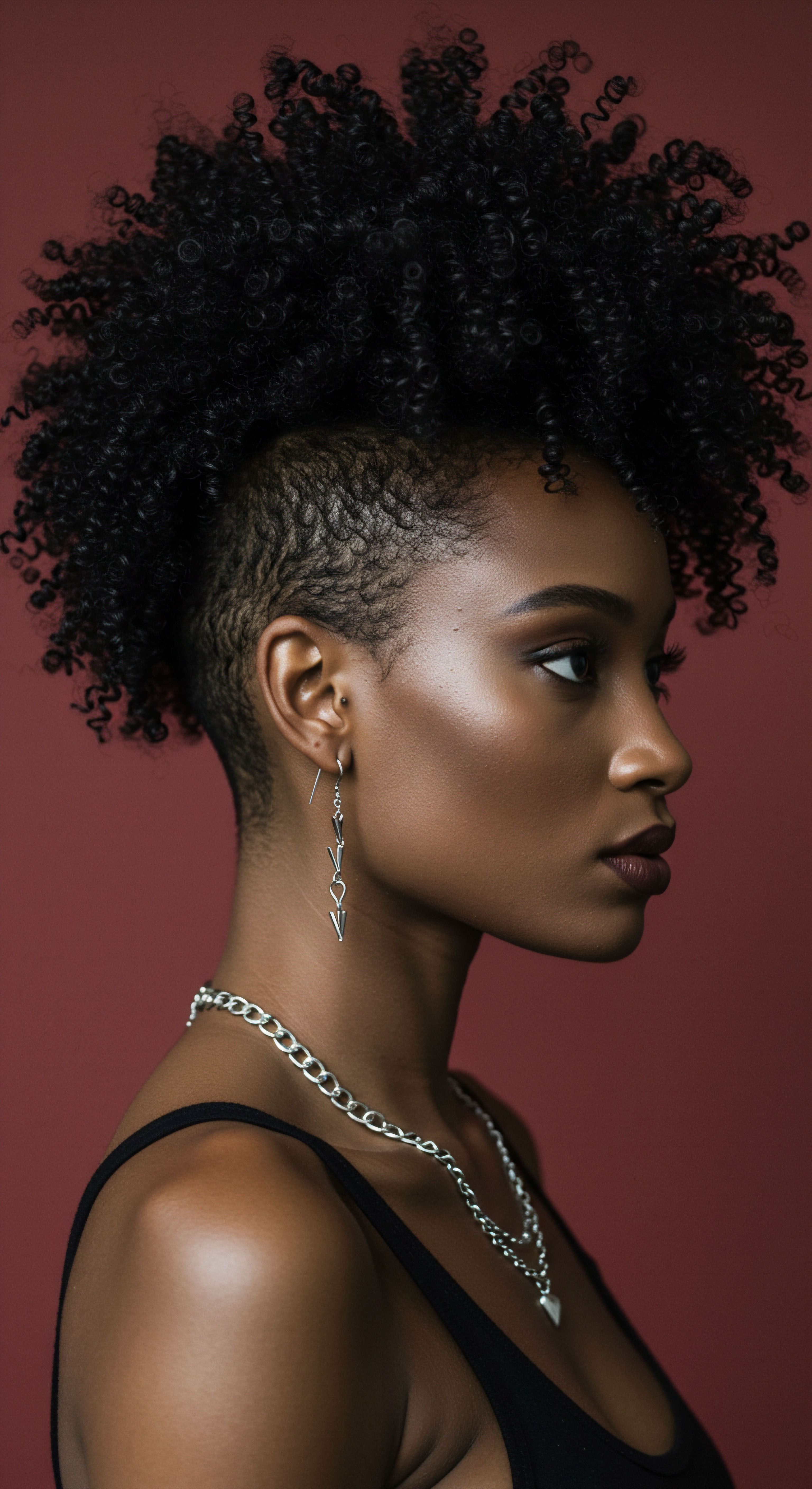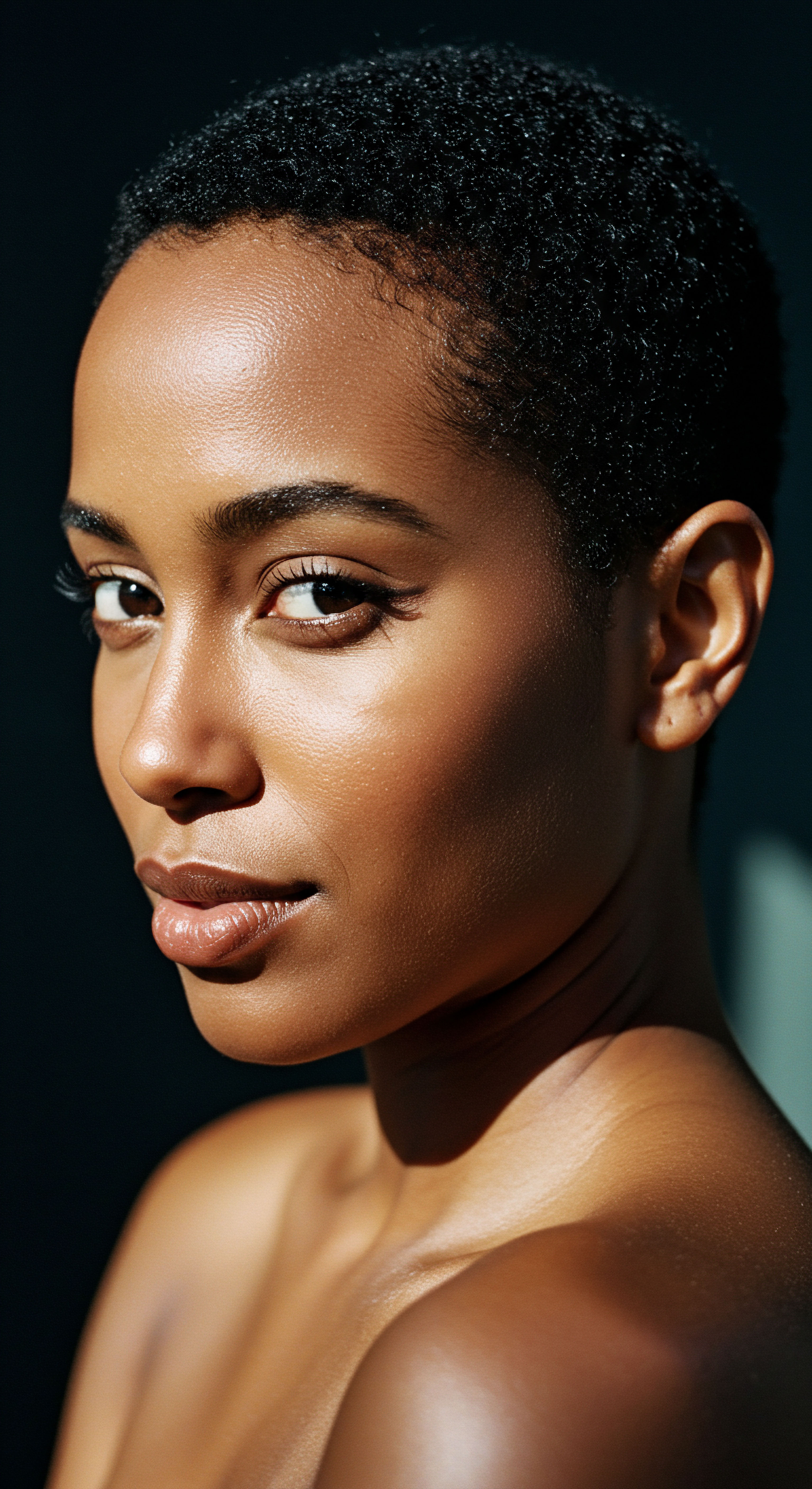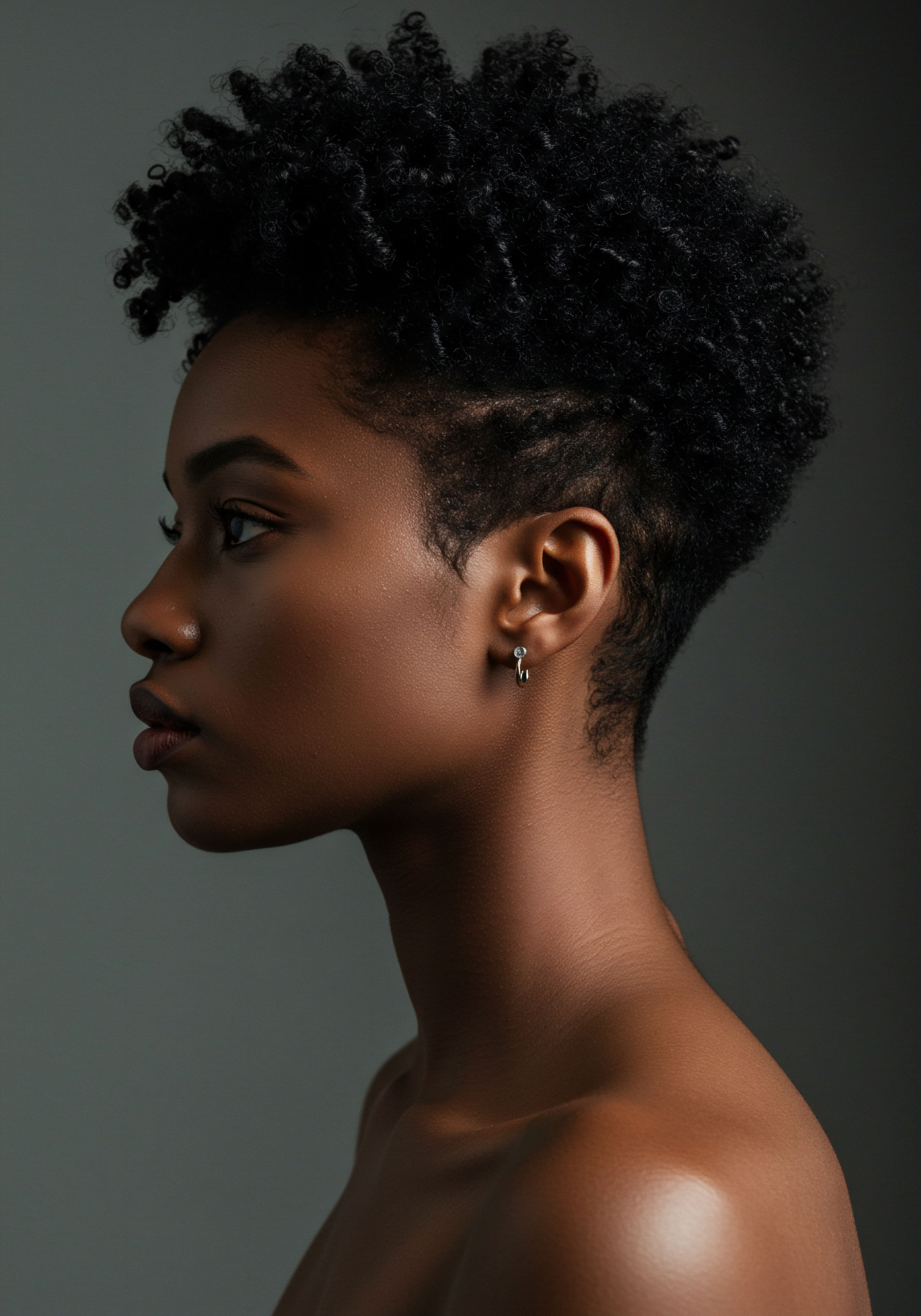
Roots
There exists a quiet conversation between the gentle rhythms of our inner world and the outward expressions of our physical being. Often, when we consider the vibrancy of our hair and scalp, our thoughts drift to external applications, to the oils, the creams, the careful manipulations of our strands. Yet, a deeper understanding invites us to look inward, to the silent, restorative hours we spend in slumber. Can the quality of our sleep truly alter the delicate balance of oil upon our scalp?
It is a question that, when thoughtfully considered, reveals a profound connection, reaching into the very foundational workings of our physiology. The scalp, much like the skin across our body, is a living canvas, its condition reflecting more than just surface interactions. It whispers tales of our internal harmony, or perhaps, our disquiet.

The Scalp’s Living Surface
Our scalp, a remarkable expanse of skin, serves as the very ground from which our hair springs. It is a complex ecosystem, home to millions of tiny structures, each playing a role in the overall health and appearance of our strands. Among these, the Sebaceous Glands stand as diligent, if sometimes overzealous, custodians of our scalp’s natural lubrication. These microscopic glands, nestled within the dermis, are intimately associated with our hair follicles.
Their purpose is clear ❉ to produce sebum, a complex blend of lipids, waxes, and squalene. Sebum is not merely an oily coating; it is a vital, protective film, a natural conditioner that helps to shield the scalp and hair from environmental stressors, maintain suppleness, and prevent excessive moisture loss. A balanced production of sebum contributes to a healthy, resilient scalp and hair that possesses a natural sheen.
When we consider the intricate workings of the scalp, we recognize that it is not a static entity. It is a dynamic landscape, constantly adapting to internal signals and external influences. The very existence of sebaceous glands and their output speaks to a built-in system of self-regulation, a continuous effort to maintain equilibrium.
The question then becomes, what factors whisper instructions to these glands, guiding their daily output? Could the profound quiet of a restful night be one such influential voice?

The Daily Cycle of Skin and Scalp
Our bodies, in their magnificent design, operate on intricate schedules, often unseen yet deeply impactful. These are our Circadian Rhythms, internal biological clocks that orchestrate a roughly 24-hour cycle of physiological processes. From our sleep-wake patterns to hormone secretion and cellular repair, these rhythms govern nearly every aspect of our being, including the subtle shifts occurring within our skin and scalp.
The skin, our largest organ, possesses its own set of these internal timekeepers, synchronized with the master clock in our brain. This means that skin functions, such as cell turnover, barrier repair, and indeed, sebum production, do not remain constant throughout the day and night.
Research has long pointed to a daily ebb and flow in the rate of facial sebum secretion. It has been observed that sebum production tends to be lowest during the night hours, gently rising as the day progresses and often reaching its peak in the early afternoon. This natural fluctuation suggests that our scalp’s oiliness is not simply a random occurrence but is, to a degree, programmed into our biological blueprint.
When our sleep patterns align with these inherent rhythms, our body’s systems, including those responsible for sebaceous gland activity, can function with greater harmony. A gentle whisper of understanding reminds us that working against these natural cycles can introduce discord, potentially altering the very balance we seek to maintain.
The scalp’s sebaceous glands produce sebum, a protective lipid film that naturally conditions hair and skin.

Anatomy of Hair Follicles and Oil Glands
To truly appreciate the connection between sleep and scalp oiliness, a closer look at the hair follicle itself offers deeper understanding. Each hair strand emerges from a tiny indentation in the skin, the hair follicle, a complex mini-organ. Attached to almost every hair follicle (with exceptions like the palms and soles of our feet) is at least one sebaceous gland. This intimate pairing highlights their codependent relationship ❉ the gland provides the oil that lubricates the emerging hair shaft, helping to keep it supple and protected as it grows.
The structure of these glands is quite remarkable. They are holocrine glands, meaning their cells accumulate lipids and then burst, releasing their entire cellular contents, including the oily sebum, into the hair follicle and onto the skin surface. The rate at which these cells mature and rupture, and thus the amount of sebum released, is influenced by a multitude of factors, both internal and external.
Hormonal signals, particularly androgens, play a significant role in stimulating sebaceous gland activity. But beyond direct hormonal command, the overall physiological state of the body, heavily influenced by rest and restoration, also sends its messages.
| Component Sebaceous Glands |
| Role in Oiliness Produce sebum, the natural scalp oil. |
| Sleep Connection Activity influenced by hormones and circadian rhythms, both tied to sleep. |
| Component Hair Follicles |
| Role in Oiliness The conduit for sebum release onto the scalp and hair. |
| Sleep Connection Their health and function are affected by systemic factors modulated by sleep. |
| Component Circadian Rhythms |
| Role in Oiliness Govern daily fluctuations in sebum production. |
| Sleep Connection Disruption through poor sleep can alter natural oil balance. |
| Component Hormones (e.g. Cortisol) |
| Role in Oiliness Signal sebaceous glands to increase or decrease oil output. |
| Sleep Connection Levels of these hormones are directly impacted by sleep quality. |

Hair Growth Cycles and Their Silent Partners
Our hair does not grow continuously; it follows a cyclical pattern, moving through phases of growth (anagen), regression (catagen), and rest (telogen), before shedding and beginning anew. While the direct influence of sleep quality on the hair growth cycle itself is a field of ongoing discovery, the broader health of the scalp environment, which sleep undeniably affects, creates the optimal conditions for these cycles to proceed without undue interruption. A scalp that is in a state of chronic inflammation or imbalance, potentially due to persistent sleep disturbances, may not offer the most hospitable environment for robust hair growth or for the sebaceous glands to function optimally.
Consider the subtle dance between our body’s repair mechanisms and these growth cycles. During periods of deep rest, our body dedicates resources to cellular regeneration and repair. If these restorative processes are hindered by insufficient or fragmented sleep, the scalp’s ability to maintain its protective barrier and regulate its functions, including oil production, could be compromised. This foundational understanding helps us appreciate that scalp oiliness, while seemingly a simple surface concern, is often a reflection of deeper, interconnected physiological harmonies.

Ritual
Stepping from the quiet contemplation of our inner workings, we arrive at the realm of daily practice, of the mindful movements and deliberate choices that shape our interaction with our textured hair. This section turns its gaze to the practical wisdom that emerges when we consider the query ❉ Can sleep quality alter scalp oiliness? It invites us to consider how our nighttime rituals, the moments before we surrender to rest, and the quality of that rest itself, can profoundly influence the delicate balance of our scalp’s natural oils. It is a space where the science of our being meets the art of our care, guiding us toward practices that honor our hair’s unique needs.

The Nighttime Sanctuary
The hours of darkness, when the world quiets, offer a profound opportunity for renewal, not only for our minds and bodies but also for our scalp and hair. During this period, our skin, including the scalp, enters a reparative mode. Blood flow to the skin increases, delivering vital nutrients and oxygen to cells, aiding in their regeneration. This is a time when the body is naturally geared towards restoration, a silent, industrious process unfolding beneath the surface.
Yet, this restorative window can be disrupted by inadequate sleep. When rest is fragmented or insufficient, the body remains in a state of heightened alert, often characterized by elevated levels of stress hormones. This prolonged state of physiological stress can have direct consequences for the scalp’s oil production.
Conversely, when we cultivate a serene nighttime sanctuary, allowing for deep, uninterrupted rest, we create the ideal conditions for our scalp’s natural rhythms to recalibrate. This allows for a more balanced production of sebum, rather than the reactive overproduction that can occur when the body perceives itself under duress.

Does Sleep Duration Influence Scalp Oil Production?
The relationship between sleep duration and scalp oiliness is a subject that invites careful consideration. While the body’s sebaceous glands exhibit a circadian rhythm with lower activity at night, chronic sleep deprivation can upset this natural balance. When we consistently shortchange our sleep, our body interprets this as a form of stress.
In response, the adrenal glands release more Cortisol, often termed the “stress hormone.” Elevated cortisol levels have a direct link to increased sebaceous gland activity. This means that a persistent lack of restful sleep could indeed signal the scalp to produce more oil, leading to a feeling of greasiness or heaviness.
Consider a clinical observation ❉ Individuals experiencing prolonged periods of stress, often accompanied by poor sleep, frequently report an increase in skin oiliness and breakouts. This is not coincidental. The physiological pathways linking stress, hormones, and sebaceous glands are well-documented. Therefore, prioritizing adequate sleep, typically 7-9 hours for most adults, is not just about feeling rested; it is a fundamental act of care for your scalp’s delicate oil equilibrium.
Insufficient sleep can elevate stress hormones, potentially signaling the scalp to produce more oil.

The Role of Nighttime Hair Care Practices
Beyond the internal biological shifts, our external nighttime practices also hold considerable sway over scalp oiliness. For those with textured hair, protective styling and the use of bonnets or silk pillowcases are not merely aesthetic choices; they are essential rituals of care.
- Protective Styling ❉ Opting for styles like braids, twists, or buns before bed can minimize friction between your hair and pillowcase. This reduction in mechanical stress can help preserve the integrity of your hair strands and, by extension, reduce the need for your scalp to overcompensate with oil production in response to perceived dryness or damage. These styles also help to keep the hair off the scalp, potentially reducing the transfer of scalp oils down the hair shaft, especially for those with finer strands or looser textures.
- Bonnets and Silk Pillowcases ❉ The choice of sleep surface or head covering plays a surprisingly significant role. Cotton, while soft, is absorbent and can draw moisture from your hair and scalp, leading to dryness. This dryness might, in turn, prompt the sebaceous glands to produce more oil in an attempt to rehydrate the scalp. Silk or satin bonnets and pillowcases, conversely, are much gentler. They create less friction, preserving your hair’s moisture and reducing the likelihood of your scalp reacting with excess oil. They allow your hair to glide, maintaining its natural hydration and helping to keep the scalp’s oil production in a more balanced state.
- Scalp Cleansing and Conditioning ❉ Establishing a consistent, yet gentle, scalp cleansing routine is paramount. Over-washing with harsh cleansers can strip the scalp of its natural oils, leading to a rebound effect where sebaceous glands go into overdrive. Conversely, infrequent washing might allow sebum and product buildup to accumulate, leading to an oily feeling. Finding the right balance for your unique scalp, often involving co-washing or using sulfate-free shampoos, is a ritual that supports optimal oil regulation, especially when combined with restful sleep.

Product Choices and Sleep’s Influence
The products we choose to apply to our scalp and hair, particularly before bed, can interact with the effects of sleep on oiliness. Heavy oils or creams applied generously to the scalp at night, especially if sleep is restless or involves excessive tossing and turning, can simply sit on the surface, contributing to a feeling of greasiness upon waking. This is not necessarily due to increased natural oil production, but rather a combination of product accumulation and the scalp’s overnight processes.
Consider the ingredients in your nighttime scalp treatments. Some ingredients are designed to regulate sebum production, while others might provide hydration. Understanding how these interact with your scalp’s natural overnight rhythm is key.
For example, if your scalp tends to be oilier after poor sleep, opting for lighter, non-comedogenic scalp serums or leaving treatments on for shorter periods before rinsing might be beneficial. The aim is to support the scalp’s natural functions, not to overburden them.
The ritual of preparing for sleep, from winding down our minds to tending to our hair with care, becomes a profound act of self-kindness that extends to the very health of our scalp. When we honor these moments, we allow our body’s inherent wisdom to guide us toward balance, softening the tendency towards excessive oiliness that can sometimes accompany the hurried pace of modern life.

Relay
Having explored the foundational elements and the daily rituals that shape our scalp’s well-being, we now step onto a broader landscape, one where the intricate dance of our internal systems meets the whispers of cultural practice and scientific discovery. This section delves into the deeper question of how sleep quality, in its profound complexity, can truly reshape the narrative of scalp oiliness. It is here that we connect the dots between biological imperatives, the subtle shifts in our cellular world, and the wider context of our health, inviting a more sophisticated understanding of this seemingly simple concern.

The Hormonal Orchestra and Scalp Oiliness
The human body operates as a magnificent orchestra, with hormones acting as the conductors, directing various physiological processes. Sleep, or its absence, plays a significant role in tuning this orchestra, particularly influencing the production and regulation of hormones that directly impact sebaceous gland activity.
The most prominent player in this hormonal symphony, when sleep is disturbed, is Cortisol. This steroid hormone, released by the adrenal glands, is a cornerstone of our body’s stress response. While vital for short-term survival, chronic elevation of cortisol, often a direct consequence of prolonged sleep deprivation or poor sleep quality, can lead to a cascade of effects, including heightened sebum production.
Cortisol receptors are present in the skin, and when excessively activated, they signal sebaceous glands to become more active, resulting in an oilier scalp and skin. This mechanism helps explain why periods of intense stress, often marked by restless nights, frequently coincide with increased breakouts and a greasier scalp.
Beyond cortisol, other hormones indirectly affected by sleep can also play a part. Growth hormone, for instance, is predominantly released during deep, slow-wave sleep. While its primary role is cell regeneration and repair, its overall influence on cellular metabolism can contribute to the healthy functioning of skin and scalp. Disruptions to this delicate hormonal balance, whether through consistent late nights or fragmented rest, can subtly yet profoundly shift the scalp’s natural equilibrium.

The Silent Language of the Skin Barrier
The scalp, as a continuation of our skin, possesses a vital protective layer known as the Skin Barrier. This barrier, composed of lipids and skin cells, acts as a guardian, preventing excessive water loss (transepidermal water loss or TEWL) and shielding against external irritants and microbes. Sleep plays a critical role in maintaining the integrity of this barrier. Studies have consistently shown that poor sleep quality diminishes the skin barrier function, leading to increased TEWL and reduced hydration.
Here lies a subtle yet powerful connection to scalp oiliness ❉ when the skin barrier is compromised and loses moisture, the body may attempt to compensate by increasing sebum production. This is a natural, albeit sometimes overzealous, protective response. The scalp, perceiving itself as dry or vulnerable, signals the sebaceous glands to produce more oil to re-lubricate and re-seal the surface.
Thus, what might appear as simply “oily” could, in some instances, be a symptom of underlying dehydration and a compromised barrier function, all stemming from insufficient restorative sleep. This phenomenon underscores the complex interplay between hydration, barrier health, and oil production, a cycle profoundly influenced by our nightly repose.
Sleep quality influences hormonal balance and skin barrier integrity, both of which shape scalp oil production.

Microbiome Shifts and Their Scalp Manifestations
Beneath the surface of our scalp, and indeed all over our skin, thrives a bustling community of microorganisms – our Skin Microbiome. This intricate ecosystem of bacteria, fungi, and viruses lives in a symbiotic relationship with our skin, contributing to its health, immune responses, and even the metabolism of sebum. Disruptions to this delicate balance, known as dysbiosis, can have wide-ranging effects, including alterations in sebum composition and production, potentially leading to increased oiliness or other skin concerns.
Emerging research highlights the connection between sleep patterns and the skin microbiome. A study published in Clinical, Cosmetic and Investigational Dermatology in 2022 examined the impact of regular late bedtime on the skin physiological characteristics and facial bacterial microbiome of 219 Chinese women aged 18–38 years. The findings were quite compelling ❉ the late bedtime group exhibited a significant increase in sebum content and a decrease in skin hydration, firmness, and elasticity. Furthermore, the analysis revealed a significant reduction in both the abundance and diversity of the facial bacterial microbiota in the late bedtime group.
Specifically, the abundance of Pseudomonas increased significantly, while beneficial species like Streptococcus, Stenotrophomonas, Acinetobacter, Haemophilus, Actinomyces, and Neisseria decreased. This data suggests that a consistently disrupted sleep schedule, exemplified by late bedtimes, does not just affect hormones; it reshapes the very microbial landscape of our skin, leading to tangible changes in oil production and overall skin health. This offers a powerful, perhaps even surprising, layer to our understanding of scalp oiliness, linking it to the unseen world of our microbial companions.

Inflammation and Scalp Health
Sleep, or the lack of it, is a potent regulator of our body’s inflammatory responses. Chronic sleep deprivation is known to elevate levels of pro-inflammatory cytokines, chemical messengers that can trigger and sustain inflammation throughout the body, including the scalp.
For the scalp, this increased inflammatory state can manifest in various ways. Inflamed sebaceous glands may become overactive, producing more sebum as a reactive measure. Additionally, inflammation can compromise the scalp’s barrier, leading to irritation, redness, and a vicious cycle of compensatory oil production.
In conditions like seborrheic dermatitis, which involves an overgrowth of yeast that thrives on sebum, heightened inflammation coupled with increased oil production due to poor sleep could exacerbate symptoms. The interconnectedness here is undeniable ❉ a well-rested body maintains a more balanced inflammatory profile, which in turn supports a calmer, less reactive scalp environment and more regulated sebum output.

The Interplay of Lifestyle and Scalp Oiliness
Our modern lives, with their demanding schedules and constant digital engagement, often nudge us towards habits that compromise our sleep. The temptation to stay awake longer, to work, to socialize, or to simply scroll, can inadvertently set in motion a chain of physiological responses that ripple through our systems, eventually reaching our scalp. This intricate web of lifestyle choices, particularly those surrounding rest, paints a picture of scalp oiliness that extends far beyond simple genetics or hygiene.
It becomes clear that optimizing sleep quality is not merely a recommendation for overall wellness; it is a direct intervention in the delicate mechanisms that govern our scalp’s oil production. When we choose to honor our body’s need for profound rest, we are, in essence, offering our sebaceous glands a gentle invitation to find their natural rhythm, to produce sebum in a balanced measure that truly serves the health and vibrancy of our textured hair. The wisdom lies in recognizing that the beauty of our hair is often a mirror reflecting the deeper care we extend to our entire being, beginning with the quiet hours of the night.

Reflection
As the quiet settles and the last echoes of scientific inquiry fade, we are left with a gentle understanding ❉ the health of our scalp, and particularly the balance of its natural oils, is profoundly intertwined with the sanctity of our sleep. It is a subtle conversation, often overlooked, yet its whispers shape the very texture and appearance of our strands. The wisdom we gather reminds us that true care for our textured hair extends beyond the visible, reaching into the unseen rhythms of our being. May this knowledge guide us to cultivate not just external rituals, but an internal harmony that allows our hair to truly shine, a testament to the restorative power of deep, abiding rest.

References
- Hirotsu, C. Rydlewski, M. Araújo, M. S. Tufik, S. & Andersen, M. L. (2012). Sleep Loss and Cytokines Levels in an Experimental Model of Psoriasis. PLoS ONE, 7(11) ❉ e51183.
- Li, S. Jiang, S. Li, Y. & Ma, L. (2022). Regular Late Bedtime Significantly Affects the Skin Physiological Characteristics and Skin Bacterial Microbiome. Clinical, Cosmetic and Investigational Dermatology, 15, 1051-1064.
- Chung, S. J. Kim, M. K. Kim, Y. M. & Kim, J. Y. (2017). The Effects of Sleep Deprivation on the Biophysical Properties of Facial Skin. Annals of Dermatology, 29(4), 415–422.
- Draelos, Z. D. (2018). The science of beauty sleep ❉ how your circadian rhythm affects your skin. Journal of Clinical and Aesthetic Dermatology, 11(8), 24-28.
- Glowacka, A. & Pabis, A. (2023). Sleep quality among adult patients with chronic dermatoses. Advances in Dermatology and Allergology, 40(1), 1-10.
- O’Leary, A. (2016). The Science of Sleep and Skin Health. Clinical and Experimental Dermatology, 41(5), 517-522.
- Hashimoto, S. & Kawakami, T. (2009). Circadian rhythm in human sebum secretion. Archives of Dermatological Research, 301(5), 329-333.
- Krueger, J. M. & Majde, J. A. (2003). Sleep and the immune system. Advances in Neuroimmunology, 8(2), 123-131.
- Hardeland, R. Pandi-Perumal, S. R. & Cardinali, D. P. (2006). Melatonin. The International Journal of Biochemistry & Cell Biology, 38(3), 316-322.
- Siegel, J. M. (2008). Duration of sleep in mammals and birds. American Journal of Physiology-Regulatory, Integrative and Comparative Physiology, 294(4), R1176-R1185.